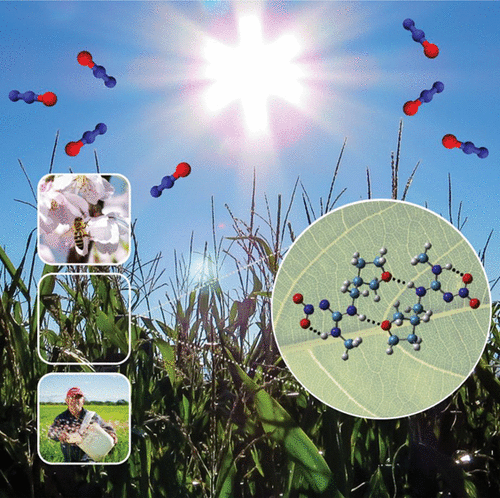当前位置:
X-MOL 学术
›
ACS Earth Space Chem.
›
论文详情
Our official English website, www.x-mol.net, welcomes your
feedback! (Note: you will need to create a separate account there.)
Probing Matrix Effects on the Heterogeneous Photochemistry of Neonicotinoid Pesticides, Dinotefuran and Nitenpyram
ACS Earth and Space Chemistry ( IF 2.9 ) Pub Date : 2021-04-30 , DOI: 10.1021/acsearthspacechem.1c00059 Andrea Rohrbacher 1 , Michael J. Ezell 1 , Véronique Perraud 1 , Barbara J. Finlayson-Pitts 1
ACS Earth and Space Chemistry ( IF 2.9 ) Pub Date : 2021-04-30 , DOI: 10.1021/acsearthspacechem.1c00059 Andrea Rohrbacher 1 , Michael J. Ezell 1 , Véronique Perraud 1 , Barbara J. Finlayson-Pitts 1
Affiliation

|
The environmental fate of neonicotinoids (NNs) is a key regulatory issue due to their widespread distribution, mobility, and role in honeybee colony collapse disorder. Here, we explore the potential matrix effects of the commercial formulations on the photochemistry of two NNs, dinotefuran (DNF) and nitenpyram (NPM). The commercial formulations and the pure reagents, both embedded in KBr pellets, were irradiated at wavelengths from 254 to 350 nm. Loss of the NN and product formation were followed using Fourier transform infrared spectroscopy and direct analysis in real time mass spectrometry. Quantum yields for loss of NN in commercial formulations were within experimental error of the pure NN. However, quantum yields for loss in KBr were consistently smaller than those previously measured for thin films of pure compounds, suggesting increased quenching of excited intermediates in the dense solid KBr matrix. At 350 nm where NPM absorbs, the quantum yield for loss in the formulation was about half that of the pure compound, which was attributed to a reduction in the NPM absorption cross section due to the presence of water taken up by additional formulation ingredients. Major products of DNF and NPM photolysis were the same in the formulation and in the pure compound. However, in contrast to previous thin film measurements, unexpected infrared peaks at 2222 and 2136 cm–1 during photolysis of DNF in KBr were identified as N2O trapped in the KBr matrix and NO+, respectively. Overall, the presence of other compounds in the formulations did not significantly alter the photochemistry compared to the pure compounds.
中文翻译:

探测基质对新烟碱类农药二甲呋喃和硝苯并吡喃非均相光化学的影响
新烟碱(NNs)的环境命运是一个关键的监管问题,因为它们的广泛分布,流动性以及在蜜蜂菌落崩溃中的作用。在这里,我们探讨了商业配方对两种NN,二氯呋喃(DNF)和乙炔吡喃(NPM)的光化学的潜在基质效应。包埋在KBr颗粒中的市售制剂和纯试剂均在254至350 nm的波长下进行辐照。使用傅立叶变换红外光谱法和实时质谱法中的直接分析来跟踪NN的损失和产物的形成。商业配方中NN损失的量子产率在纯NN的实验误差范围内。但是,KBr损耗的量子产率始终小于先前对纯化合物薄膜的量子产率,提示在致密的固体KBr基质中激发中间体的猝灭作用增加。在NPM吸收的350 nm处,制剂中损失的量子产率约为纯化合物的一半,这归因于NPM吸收横截面的减少,这是由于存在其他制剂成分所吸收的水。DNF和NPM光解的主要产物在配方和纯化合物中相同。但是,与以前的薄膜测量相比,意外的红外峰出现在2222和2136 cm 这归因于由于附加配方成分吸收的水而导致NPM吸收截面的减小。DNF和NPM光解的主要产物在配方和纯化合物中相同。但是,与以前的薄膜测量相比,意外的红外峰出现在2222和2136 cm 这归因于由于附加配方成分吸收的水而导致NPM吸收截面的减小。DNF和NPM光解的主要产物在配方和纯化合物中相同。但是,与以前的薄膜测量相比,意外的红外峰出现在2222和2136 cm-1在KBr中DNF的光解过程中被确定为ñ 2 Ó被困在KBr压矩阵和NO +分别。总体而言,与纯化合物相比,制剂中其他化合物的存在不会显着改变光化学。
更新日期:2021-05-20
中文翻译:

探测基质对新烟碱类农药二甲呋喃和硝苯并吡喃非均相光化学的影响
新烟碱(NNs)的环境命运是一个关键的监管问题,因为它们的广泛分布,流动性以及在蜜蜂菌落崩溃中的作用。在这里,我们探讨了商业配方对两种NN,二氯呋喃(DNF)和乙炔吡喃(NPM)的光化学的潜在基质效应。包埋在KBr颗粒中的市售制剂和纯试剂均在254至350 nm的波长下进行辐照。使用傅立叶变换红外光谱法和实时质谱法中的直接分析来跟踪NN的损失和产物的形成。商业配方中NN损失的量子产率在纯NN的实验误差范围内。但是,KBr损耗的量子产率始终小于先前对纯化合物薄膜的量子产率,提示在致密的固体KBr基质中激发中间体的猝灭作用增加。在NPM吸收的350 nm处,制剂中损失的量子产率约为纯化合物的一半,这归因于NPM吸收横截面的减少,这是由于存在其他制剂成分所吸收的水。DNF和NPM光解的主要产物在配方和纯化合物中相同。但是,与以前的薄膜测量相比,意外的红外峰出现在2222和2136 cm 这归因于由于附加配方成分吸收的水而导致NPM吸收截面的减小。DNF和NPM光解的主要产物在配方和纯化合物中相同。但是,与以前的薄膜测量相比,意外的红外峰出现在2222和2136 cm 这归因于由于附加配方成分吸收的水而导致NPM吸收截面的减小。DNF和NPM光解的主要产物在配方和纯化合物中相同。但是,与以前的薄膜测量相比,意外的红外峰出现在2222和2136 cm-1在KBr中DNF的光解过程中被确定为ñ 2 Ó被困在KBr压矩阵和NO +分别。总体而言,与纯化合物相比,制剂中其他化合物的存在不会显着改变光化学。











































 京公网安备 11010802027423号
京公网安备 11010802027423号